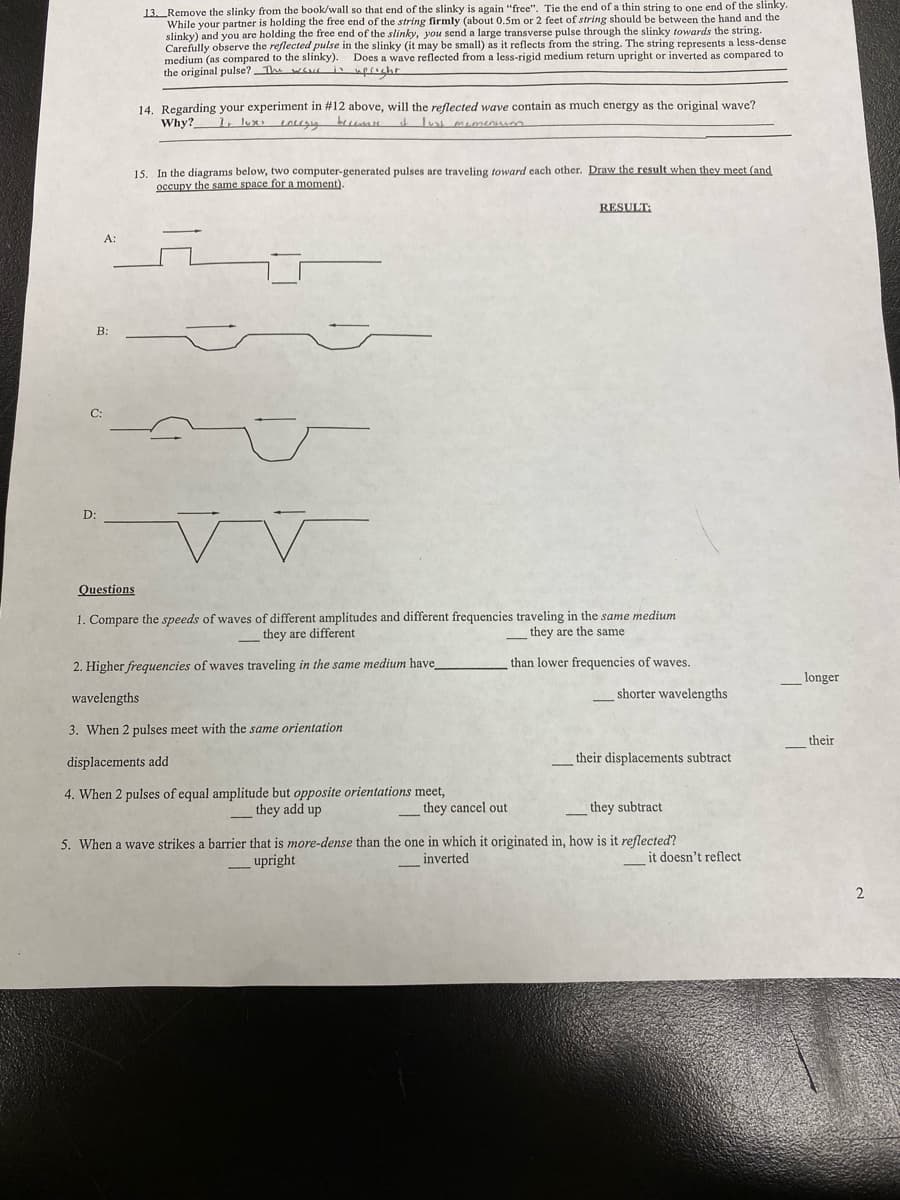1. Compare the speeds of waves of different amplitudes and different frequencies traveling in the same medium they are different they are the same 2. Higher frequencies of waves traveling in the same medium have_ than lower frequencies of waves. wavelengths 3. When 2 pulses meet with the same orientation isplacements add - When 2 pulses of equal amplitude but opposite orientations meet, they add up they cancel out shorter wavelengths their displacements subtract they subtract When a wave strikes a barrier that is more-dense than the one in which it originated in, how is it reflected? upright inverted it doesn't reflect longer their
1. Compare the speeds of waves of different amplitudes and different frequencies traveling in the same medium they are different they are the same 2. Higher frequencies of waves traveling in the same medium have_ than lower frequencies of waves. wavelengths 3. When 2 pulses meet with the same orientation isplacements add - When 2 pulses of equal amplitude but opposite orientations meet, they add up they cancel out shorter wavelengths their displacements subtract they subtract When a wave strikes a barrier that is more-dense than the one in which it originated in, how is it reflected? upright inverted it doesn't reflect longer their
University Physics Volume 1
18th Edition
ISBN:9781938168277
Author:William Moebs, Samuel J. Ling, Jeff Sanny
Publisher:William Moebs, Samuel J. Ling, Jeff Sanny
Chapter5: Newton's Law Of Motion
Section: Chapter Questions
Problem 105CP: Hanging from the ceiling over a baby bed, well out of baby’s reach, is a string with plastic shapes,...
Related questions
Question
Please answer the questions at the end (1-5)

Transcribed Image Text:A:
B:
C:
D:
13. Remove the slinky from the book/wall so that end of the slinky is again "free". Tie the end of a thin string to one end of the slinky.
While your partner is holding the free end of the string firmly (about 0.5m or 2 feet of string should be between the hand and the
slinky) and you are holding the free end of the slinky, you send a large transverse pulse through the slinky towards the string.
Carefully observe the reflected pulse in the slinky (it may be small) as it reflects from the string. The string represents a less-dense
medium (as compared to the slinky). Does a wave reflected from a less-rigid medium return upright or inverted as compared to
the original pulse? The was in upright
14. Regarding your experiment in #12 above, will the reflected wave contain as much energy as the original wave?
Why? 1 luxes energing becerase it lust momentum
15. In the diagrams below, two computer-generated pulses are traveling toward each other. Draw the result when they meet (and
occupy the same space for a moment).
r
Questions
1. Compare the speeds of waves of different amplitudes and different frequencies traveling in the same medium
they are different
they are the same
than lower frequencies of waves.
2. Higher frequencies of waves traveling in the same medium have
wavelengths
3. When 2 pulses meet with the same orientation
displacements add
4. When 2 pulses of equal amplitude but opposite orientations meet,
they add up
-
-
RESULT:
they cancel out
shorter wavelengths
their displacements subtract
they subtract
5. When a wave strikes a barrier that is more-dense than the one in which it originated in, how is it reflected?
_upright
inverted
-
it doesn't reflect
longer
their
2
Expert Solution
This question has been solved!
Explore an expertly crafted, step-by-step solution for a thorough understanding of key concepts.
This is a popular solution!
Trending now
This is a popular solution!
Step by step
Solved in 2 steps

Knowledge Booster
Learn more about
Need a deep-dive on the concept behind this application? Look no further. Learn more about this topic, physics and related others by exploring similar questions and additional content below.Recommended textbooks for you

University Physics Volume 1
Physics
ISBN:
9781938168277
Author:
William Moebs, Samuel J. Ling, Jeff Sanny
Publisher:
OpenStax - Rice University

Physics for Scientists and Engineers with Modern …
Physics
ISBN:
9781337553292
Author:
Raymond A. Serway, John W. Jewett
Publisher:
Cengage Learning

Physics for Scientists and Engineers
Physics
ISBN:
9781337553278
Author:
Raymond A. Serway, John W. Jewett
Publisher:
Cengage Learning

University Physics Volume 1
Physics
ISBN:
9781938168277
Author:
William Moebs, Samuel J. Ling, Jeff Sanny
Publisher:
OpenStax - Rice University

Physics for Scientists and Engineers with Modern …
Physics
ISBN:
9781337553292
Author:
Raymond A. Serway, John W. Jewett
Publisher:
Cengage Learning

Physics for Scientists and Engineers
Physics
ISBN:
9781337553278
Author:
Raymond A. Serway, John W. Jewett
Publisher:
Cengage Learning

Physics for Scientists and Engineers, Technology …
Physics
ISBN:
9781305116399
Author:
Raymond A. Serway, John W. Jewett
Publisher:
Cengage Learning

Physics for Scientists and Engineers: Foundations…
Physics
ISBN:
9781133939146
Author:
Katz, Debora M.
Publisher:
Cengage Learning

Classical Dynamics of Particles and Systems
Physics
ISBN:
9780534408961
Author:
Stephen T. Thornton, Jerry B. Marion
Publisher:
Cengage Learning